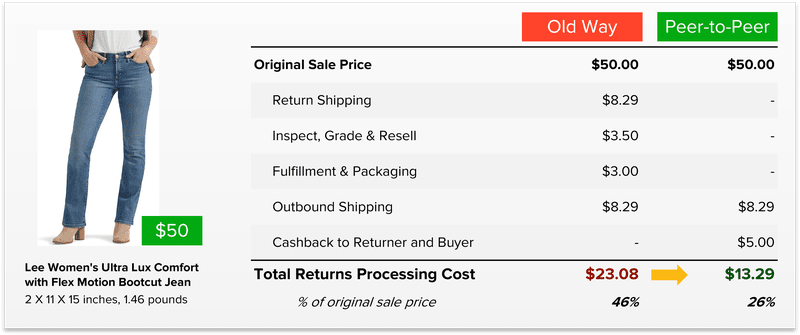The Future of Returns in Ecommerce: Trends to Watch

Last updated on April 15, 2025

In this article
 8 minutes
8 minutes
- Why Ecommerce Returns Are Everyone’s Problem
- The Big Picture: A Shift in Shopper Behavior and Business Priorities
- Trend #1: Returns Automation and Smart Reverse Logistics
- Trend #2: Peer-to-Peer Returns, A Circular Economy in Action
- Trend #3: Returnless Refunds and Smarter Policies
- Trend #4: Sustainability Is No Longer Optional
- Trend #5: Real-Time Product Insights and Smarter PDPs
- Trend #6: Personalization Comes to Returns
- Trend #7: Returns as Part of the Purchase Decision
- Trend #8: In-Store Returns for Online Orders
- Trend #9: Handling Holiday Return Spikes with Flexibility
- Trend #10: Data-Driven Returns Strategy
- Final Thoughts: Returns in Ecommerce as a Brand Advantage
- Quick Checklist: Elements of a High-Performance Return Policy
- Frequently Asked Questions
Why Ecommerce Returns Are Everyone’s Problem
Returns in ecommerce are a growing force that can either erode profits or enhance customer loyalty, depending on how well you manage them. With ecommerce sales climbing year over year, the volume of online orders is higher than ever, and with that comes an increase in customer returns. The challenge? Online shoppers today expect a seamless, hassle-free return policy that rivals, or even exceeds, the experience of in-store purchases at a brick-and-mortar store.
For online retailers, managing the returns process is no longer a back-office issue. It’s a core part of the customer experience, tied directly to supply chain efficiency, brand reputation, and ultimately, revenue. In this article, we explore where ecommerce returns are headed in 2025 and beyond, and what ecommerce businesses need to do to keep up.
The Big Picture: A Shift in Shopper Behavior and Business Priorities
According to the National Retail Federation, returns accounted for nearly $900 billion in lost revenue in 2024. For ecommerce companies, the average return rate ranges between 15% and 30%, but it can soar above 40% during the holiday season. Apparel, footwear, and electronics face high return rates due to sizing, color mismatches, and transit damage.
This isn’t just about refunding money; it’s about lost customers, wasted inventory, and disrupted operations. Yet, a well-structured returns management process can boost customer satisfaction, drive revenue through store credit incentives, and differentiate a brand in a crowded marketplace.
Trend #1: Returns Automation and Smart Reverse Logistics
Modern online businesses are embracing automation to reduce friction in processing returns. Companies like ReturnGO and Loop Returns offer tools that allow customers to initiate returns, track progress, and process refunds or exchanges via self-service portals.
AI is transforming reverse logistics by automatically determining return eligibility, choosing between refunds or store credit, and even offering personalized suggestions based on returns data. For example, if a customer repeatedly returns an item due to sizing issues, recommendations can be refined dynamically.
This approach not only improves internal systems but also enables timely processing of returns, saving money while meeting customer expectations.
Trend #2: Peer-to-Peer Returns, A Circular Economy in Action
Traditionally, returned products are shipped back to a warehouse, processed, and (maybe) resold. In the emerging peer-to-peer (P2P) returns model, shoppers ship items directly to future customers who have ordered the same product.
This model, championed by platforms like Cahoot, eliminates the need for a warehouse. For instance, Amy in Los Angeles returns a pair of jeans directly to Sarah in Casper, Wyoming, who recently purchased the same item. The brand manages the inventory update and refund process digitally.
The outcome is a reduced carbon footprint, elimination of return shipping costs, faster resale turnaround, and a more sustainable reverse logistics process. For ecommerce brands supporting circular commerce and waste reduction, this approach meets all the right criteria.
Trend #3: Returnless Refunds and Smarter Policies
Returnless refunds, where a customer keeps the product after receiving a refund, are gaining popularity—especially for low-value items where return costs outweigh resale value. When combined with predictive analytics, they can help reduce return fraud.
Offering partial refunds, store credits, or gift cards encourages future purchases and reduces the financial impact of physical returns—a win-win for both customers and businesses.
The best return policies are both flexible and structured. A hassle-free policy doesn’t mean an open door for abuse; many companies use tiered policies that offer more generous terms to loyal customers or those with a low return history, balancing customer satisfaction with profitability.
Trend #4: Sustainability Is No Longer Optional
Online purchases generate significant packaging waste and emissions, especially as returns nearly double the shipping process. Today’s ecommerce shoppers are increasingly aware of environmental costs, and brands that ignore sustainability risk alienating customers.
Businesses are rethinking returns management by adopting reusable packaging, carbon-neutral return shipping, and transparent sustainability metrics. Some brands even encourage in-store returns to reduce emissions when they have physical locations.
Other strategies include consolidating drop-off points or using third-party locker systems to reduce last-mile inefficiencies.
Trend #5: Real-Time Product Insights and Smarter PDPs
Returns often stem from mismatched expectations—whether it’s a poor fit, unexpected color, or differences between online imagery and reality. To combat this, online merchants invest in detailed product descriptions, high-resolution photos, user-generated content, and 3D virtual try-ons.
Product pages now feature size guidance, material indicators, and customer reviews to set realistic expectations. Analyzing returns data helps merchants adjust descriptions or imagery to lower future returns.
Trend #6: Personalization Comes to Returns
The era when every customer had to endure the same return experience is ending. Ecommerce companies now leverage customer behavior data to create personalized return flows.
For example, a loyal customer with a clean return history might be offered instant store credit and free return shipping, whereas a new customer could be asked to return the product before receiving a refund. Some systems even adjust policies based on product type or return frequency to deter abuse and reward loyal behavior.
This personalized approach improves customer experience, manages risk, and treats each customer as an individual rather than just a transaction.
Trend #7: Returns as Part of the Purchase Decision
Retailers are recognizing that return policies are no longer just post-sale features—they influence the pre-sale decision. Studies reveal that savvy online shoppers routinely review return policies before making a purchase. A generous, clear policy can boost conversion rates, especially for high-consideration items such as electronics or luxury apparel.
Retailers now highlight key return features like free returns, fast refund processing, or extended holiday return windows directly on product pages, reassuring potential buyers and capturing demand from hesitant customers.
Trend #8: In-Store Returns for Online Orders
Despite the continued growth of online shopping, many ecommerce brands are opening showrooms or pop-up locations to facilitate returns and exchanges. This strategy bridges the gap between ecommerce and brick-and-mortar, offering a physical touchpoint for customers who prefer in-person returns.
Retailers such as Target and Walmart have invested heavily in omnichannel capabilities, offering BOPIS (Buy Online, Pick Up In Store) and BORIS (Buy Online, Return In Store) models that drive foot traffic and speed up refund processing.
In-store returns also reduce shipping costs and improve inventory management by enabling faster restocking of returned items.
Trend #9: Handling Holiday Return Spikes with Flexibility
The holiday season drives a surge in ecommerce sales—and, predictably, a spike in returns. To manage this, brands are extending return windows, automating return workflows, and staffing dedicated reverse logistics teams.
Retailers that prepare early by segmenting returns by value or category and communicating clear timelines are seeing significant improvements in both customer satisfaction and operational efficiency.
Trend #10: Data-Driven Returns Strategy
Forward-thinking ecommerce brands no longer view returns as a nuisance; they treat them as a vital source of data. By analyzing returns data, businesses can gain insights into product quality, fulfillment issues, shipping breakdowns, and customer concerns.
This analytical approach not only informs product development and customer support but also helps flag repeat return offenders, detect fraud, and fine-tune return policies over time.
Final Thoughts: Returns in Ecommerce as a Brand Advantage
The future of returns in ecommerce isn’t about eliminating them; it’s about managing them more effectively. Understanding customer expectations, providing clear policies, streamlining processes, and leveraging data to drive smarter decisions can transform returns from a cost center into a competitive advantage.
In an environment where convenience and trust are paramount, a well-executed returns experience can turn a one-time shopper into a lifelong customer.
Quick Checklist: Elements of a High-Performance Return Policy
- Clear timeframes for returns
- Easy-to-use return portal
- Free return shipping or in-store returns
- Transparent refund process (refund vs. store credit)
- Conditions for return eligibility
- Proactive updates to keep customers informed
- Mobile-optimized experience
Frequently Asked Questions
How can live exchanges (BORIS) benefit ecommerce retailers?
Live exchanges allow customers to swap products in real time, reducing return rates and enhancing customer satisfaction by providing immediate solutions.
What role does AI play in managing ecommerce returns?
AI helps predict return patterns, optimize inventory, and provide personalized recommendations, leading to reduced return rates and improved customer experiences.
How do rental models impact product returns?
Rental models offer consumers flexibility for short-term usage, which can decrease the likelihood of returns due to temporary needs or dissatisfaction.
Why is sustainability important in the returns process?
Sustainable return practices reduce environmental impact, promote brand responsibility, and align with consumer values, thereby enhancing brand reputation and customer loyalty.
What strategies can retailers implement to manage seasonal return spikes?
Retailers can extend return windows, enhance customer support, and ensure adequate staffing during peak seasons to effectively manage increased return volumes.

Up to 64% Lower Returns Processing Cost


